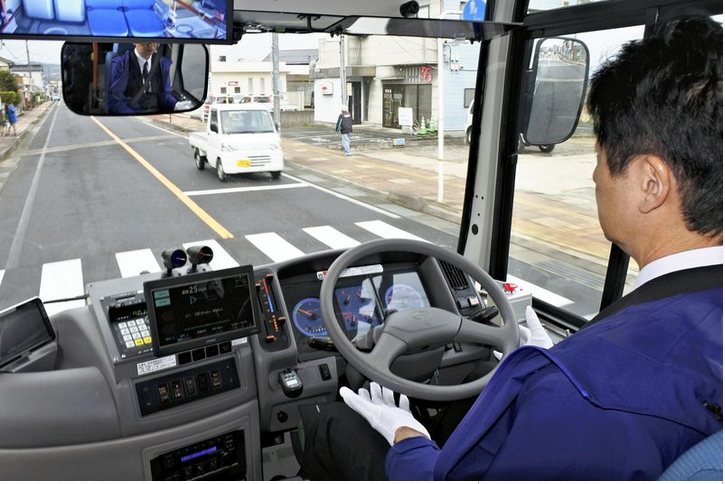Yomiuri Shimbun file photo A driver takes his hands off the steering wheel of a bus during a self-driving feasibility test in Tottori Prefecture in late March.
copyright by the-japan-news.com
 Yomiuri Shimbun file photo A driver takes his hands off the steering wheel of a bus during a self-driving feasibility test in Tottori Prefecture in late March. The Economy, Trade and Industry Ministry has for the first time compiled a strategy to foster professionals in artificial intelligence — key technologies for self-driving.
Yomiuri Shimbun file photo A driver takes his hands off the steering wheel of a bus during a self-driving feasibility test in Tottori Prefecture in late March. The Economy, Trade and Industry Ministry has for the first time compiled a strategy to foster professionals in artificial intelligence — key technologies for self-driving.
Under the strategy, the ministry plans to sort out categories of technologies necessary for software development and map out a new uniform standard for the technologies, making clear what personnel are needed when hiring new graduates or recruiting IT personnel from other businesses.
The ministry also is expected to open courses at universities or by other means to train AI experts so Japanese automakers and others that suffer from a shortage of such workers can obtain necessary human resources easily.
The ministry will announce the strategy as early as Monday.
Self-driving mainly needs the following three functions: Yomiuri Shimbun file photo A monitor aboard the bus shows situations outside the bus. Artificial intelligence recognizes passengers and vehicles, and overlays markers for them in different colors.
■ Cognitive function to assess the location of a vehicle and its surrounding situation with camera and sensor inputs.
■ Judgment function for AI and other technologies to select an appropriate action depending on the situation.
Thank you for reading this post, don't forget to subscribe to our AI NAVIGATOR!
■ Operation function based on the AI’s judgment.
Under the new uniform standard compiled by the ministry’s working group, technologies necessary for software development are largely sorted into three categories — “cognition,” “judgment” and “operation,” and concrete technologies for each category are listed.
For example, the cognition category technologies are defined as “technologies to recognize the location of a car with the combination of sensor data from a mounted camera, radar and other equipment, and outside data from maps and other means.”
With the definition, the standard specifies that the main technologies required in the category are to process camera images, recognize objects in the images and process map data. The standard also set further concrete conditions such as simultaneous imaging with a compound eye camera to measure distances.[…]
read more – copyright by the-japan-news.com


Yomiuri Shimbun file photo A driver takes his hands off the steering wheel of a bus during a self-driving feasibility test in Tottori Prefecture in late March.
copyright by the-japan-news.com
Under the strategy, the ministry plans to sort out categories of technologies necessary for software development and map out a new uniform standard for the technologies, making clear what personnel are needed when hiring new graduates or recruiting IT personnel from other businesses.
The ministry also is expected to open courses at universities or by other means to train AI experts so Japanese automakers and others that suffer from a shortage of such workers can obtain necessary human resources easily.
The ministry will announce the strategy as early as Monday.
Self-driving mainly needs the following three functions: Yomiuri Shimbun file photo A monitor aboard the bus shows situations outside the bus. Artificial intelligence recognizes passengers and vehicles, and overlays markers for them in different colors.
■ Cognitive function to assess the location of a vehicle and its surrounding situation with camera and sensor inputs.
■ Judgment function for AI and other technologies to select an appropriate action depending on the situation.
Thank you for reading this post, don't forget to subscribe to our AI NAVIGATOR!
■ Operation function based on the AI’s judgment.
Under the new uniform standard compiled by the ministry’s working group, technologies necessary for software development are largely sorted into three categories — “cognition,” “judgment” and “operation,” and concrete technologies for each category are listed.
For example, the cognition category technologies are defined as “technologies to recognize the location of a car with the combination of sensor data from a mounted camera, radar and other equipment, and outside data from maps and other means.”
With the definition, the standard specifies that the main technologies required in the category are to process camera images, recognize objects in the images and process map data. The standard also set further concrete conditions such as simultaneous imaging with a compound eye camera to measure distances.[…]
read more – copyright by the-japan-news.com
Share this: